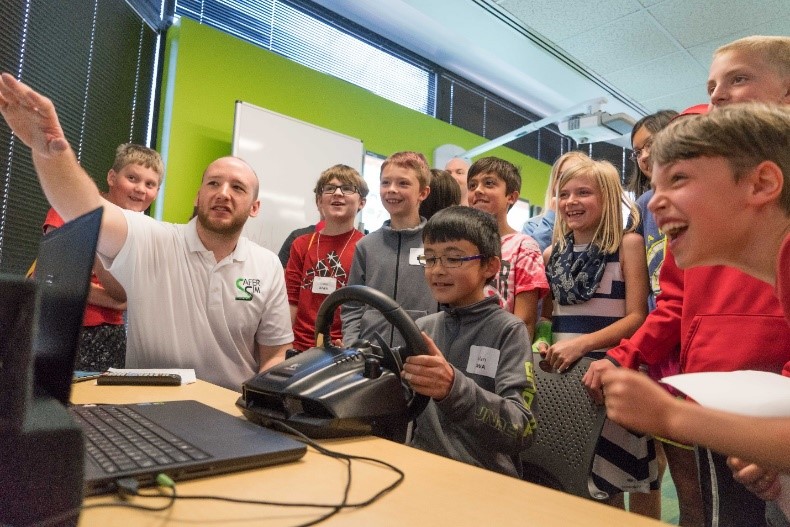Our partners at the world- renowned National Advanced Driving Simulator (NADS) take their technology on the road—and their safety messages.
Through their partnership with STEM (Science, Technology, Engineering and Mathematics), staff of NADS’s outreach program visit schools with a portable driving simulator (miniSim) to demonstrate science concepts and different driving conditions. They also bring the simulator to STEM festivals and other events around the state like the Iowa State Fair.
STEM and safety are connected in most of their activities. For example, the students learn how to interpret motion graphs based on their drives on the simulator and how friction affects the roadway and stopping distance. One of the main safety themes is distracted driving.
“This is especially important with these children who have grown up with smart phones and tablets at their side,” said Jacob Heiden, who oversees NADS’s outreach work. “They experience the dangerous effects of distracted driving in the virtual environment rather than on the road.”

Once, Heiden said, a 13-year-old student at a STEM festival was sure he could “beat” the simulator, but when a distraction occurred, the student drifted across the center line on the road in 1-2 seconds. The student was asked to read a text during the drive on a phone connected to the simulator.
“The student did not notice [the drifting] until it was too late. He crashed head-on with an oncoming vehicle, which simulated a loud noise and a cracked windshield. This event showed the student and his friends how fast a crash can occur,” Heiden said.
So far, the program has reached nearly 12,000 Iowan students. NADS hopes to have resources online so rural students or other students across the state can watch videos, download driving data, and download lesson plans.
Although the program is for kids and teens, Heiden said, engaging individuals of all ages in discussions about transportation safety is important because it affects everyone.
Heiden said, “I have heard students say, ‘my parents text and drive, and they haven’t crashed’ or ‘my dad drives with his knees while he texts.’ These statements are scary things to hear.”
Tara Troester, a STEM festival organizer and middle school parent, said the program provides opportunities for families to safely explore this topic.
“I have seen parents test their driving skills alongside their child,” she said. “The rich conversations after the simulation include an emphasis on the importance of not driving distracted.”
Heiden said parents can set a good example behind the wheel, have conversations with their children about safe driving and look for smart phone apps that promote such driving.
Read about SaferSim transportation research and STEM-related activities at the UI.
Read about UI IPRC roadway safety research.
Read here about Iowa’s new texting while driving law which went into effect July 1, 2017.


